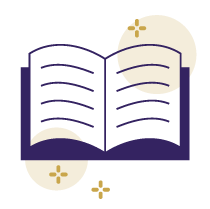
Language
Reading, Writing, Speaking and Listening
Overview
Language is a cognitive process by which we communicate our thoughts and feelings to others. When we think of language and school, most of us think about reading. But language skills encompass more than reading. We talk, we listen, we read, and we write with words. Language skills, then, include reading, writing, listening, and speaking.
Reading, writing, speaking and listening play crucial roles in school, and all four are interrelated and affect one another. There is a fundamental and reciprocal relationship among oral language (listening and speaking), written language, and reading. Initially, reading and writing are dependent on oral language skills. Eventually, reading and writing extend oral language. Young children use oral language skills to learn how to read. Older children use reading to broaden their learning.
Reading. Of the four language skills, reading has the greatest impact on school success. Substantial research in reading development and reading instruction has been funded by the National Institute of Child Health and Human Development (NICHD) within the National Institutes of Health. Since 1965, well over 45,000 children and adults from all walks of life have participated in the research (Birsh, 2005). NICHD funded researchers have now defined how children learn to read, why some children have difficulties learning to read, how we can remediate reading difficulties, and how we can prevent reading difficulties.
In 1997, in response to a congressional charge, the National Reading Panel (NRP) was created under the direction of the NICHD. The purpose of the NRP was to conduct an evidence-based assessment of the scientific research on reading and its implications for reading instruction. The panel examined over 100,000 research studies completed since 1966. The panel’s report, issued in 2000, stated that, in order to read, children must be taught alphabetics (phonemic awareness and phonics), reading fluency (speed, accuracy, expression, and ease), and reading comprehension.

The findings of the NRP report on the five components of reading instruction are summarized as follows:
- Phoneme awareness –the ability to attend to, think about and work with the individual sounds in words
- Phonics – the relationship between the sounds and written symbols of language or phoneme-grapheme correspondence
- Fluency – the ability to read text quickly and accurately
- Vocabulary – the ability to understand the meanings of the words we use to communicate
- Comprehension – the ability to derive meaning from what is read, which is the reason for reading
Poor instruction in phonemic awareness and phonics is the most common reason why students exhibit reading problems. The most common cause of reading problems other than poor instruction is dyslexia. While learning to read may be more difficult for children with dyslexia, students with dyslexia can learn to read when they are taught in a direct, sequential and cumulative fashion.
Reading problems may also be caused by breakdowns in other components such as fluency, vocabulary, and/or text comprehension. Deficits in vocabulary and text comprehension are very often associated with oral language difficulties. Poor comprehension of text may be due to challenges with attention and/or memory. Because reading problems have various causes at their root, and because these various causes are treated in different ways, it is critical to specifically identify and address all of the underlying causes.
Writing is the expressive mode of written language and involves using written symbols of language to communicate. Writing not only includes the ability to accurately represent the graphic form of speech (letters and words) but also the ability to develop and express one’s thoughts in a cohesive, structured manner. The skills required for effective writing include knowledge of spelling, capitalization, punctuation, and grammar, an understanding of how word order in sentences affects meaning, and the ability to distinguish main ideas from supporting ideas or details.
Listening involves understanding what we hear. To listen effectively, one must be able to retain “chunks” of language in short-term and working memory, recognize and understand vocabulary, recognize the stress and rhythm patterns of speech and glean meaning from context.
Speaking skills include the correct pronunciation of words, the appropriate use of vocabulary and grammar and the ability to recall words from long-term memory. The goal of speaking is to make our ideas and explanations clear and understandable to others. Effective speaking also involves the ability to use language within the social context.
Children who struggle with language often perform poorly in school because they have trouble understanding what is said to them, what they read, and expressing their thoughts to others. Students with language processing problems should receive instruction or therapy by a qualified professional, as well as receiving accommodations and modifications in the school setting, if necessary, to assure school success.
Resources
Adams, M. J. (2009). The challenge of advanced texts: The interdependence of reading and learning. In Hiebert, E. H. (ed.), Reading more, reading better: Are American students reading enough of the right stuff? New York: Guilford.
Anisfeld, M. (1994). Language development from birth to three. Hillsdale, N. J.: Erlbaum.
Armbruster, B.M. & Osborn, J. (2001). Put reading first: The research building blocks for teaching children to read. Washington, DC: The Partnership for Reading.
Beck, Isabel, McKeown, Margaret .G., and Kucan, Linda. (2013). Bringing words to life (2nd Edition). New York: Guilford.
Berninger, V. W., and Richards, T. L. (2002). Brain literacy for educators and psychologists. San Diego, CA: Academic Press.
Birch, J. R. (ed) (2011). Multisensory teaching of basic language skills (Third Edition). Baltimore, MD: Paul H. Brookes Publishing.
Fisher, D., Frey, N., and Lapp, D (2012). Text complexity: Raising rigor in reading. Newark, DE: International Reading Association.
Hall, S.L. and Moats, L.C. (2002). Parenting a struggling reader. New York: Broadway Books.
Hattie, J. (2013). Visible learning and the science of how we learn. New York: Routledge.
Lyon, G.R. (2004). The right to read and the responsibility to teach. In Thomas, A. (Ed.), Plain talk about kids: A summit on teaching and learning. Covington, LA: Learning Success Press.
McCardle, P. and Chhabra, V. (2004). The voice of evidence in reading research. Baltimore, MD: Paul H. Brookes Publishing Co.
Moats, L.C. (2004).Language essentials for teachers of reading and spelling. Book one, Modules 1 – 6. Longmont, CO: SoprisWest.
National Institute for Literacy and National Institute of Child Health and Human Development (2007). What content-area teachers should know about adolescent literacy. Jessup, MD: EdPubs.
National Institute for Child Health and Human Development (NICHD) (2000). Report of the national reading panel. (NIH Publication No. 00–4754). Washington, DC: U.S. Government Printing Office.
Shaywitz, S.E. (2003). Overcoming dyslexia. A new and complete sciencebased program for reading problems at any level. New York: Knopf Press.
Stahl, S.A. and Nagy, W.E. (2006). Teaching word meanings. Mahwah, NJ: Lawrence Erlbaum Associates.
Thomas, A. (2013). Retention is not the answer. www.cdl.org.
Thomas, A. and Thorne, G. (2010). Differentiating instruction: 150+ targeted strategies for diverse learners. Metairie, LA: Center for Development and Learning.
Thomas, A. (2010). How minds work: The key to motivation, learning and thinking. www.cdl.org.
